Abstract
Distributed generation (DG) is an important method of energy generation that accelerates the decentralization process of centralized systems, and has been widely deployed in modern society due to its economical, sustainable, and environmentally friendly characteristics. However, with the tremendous development of DG, system reliability operations are facing increasingly severe challenges because of the fluctuations of the renewable generation. In this paper, a novel spinning reserve optimization method is proposed to maximize the maximum allowance of system uncertainty (MAoSU) under the premise of satisfying the preset system operational cost. Then, the success rate of DG off-grid operation is calculated by comparing the magnitude of optimal spinning reserve capacity with the power exchange between the main grid and the distributed grid. The simulation results show that decision-makers need to increase the operational cost to compensate for system uncertainty, and the percentage increase of the operational cost is in proportional to the MAoSU and system renewable energy penetration rate. Additionally, with the increase of the MAoSU, the system needs to prepare more spinning reserve capacity to maintain system reliability operations. Finally, with the decrease of the MAoSU, the success rate of system off-grid operation decreases sharply, especially when the MAoSU is less than 0.5.
1. Introduction
With the rapid growth of electricity demands, more and more fossil energy is consumed in traditional centralized systems to maintain power system stability operation, which has already resulted in environmental disruption. As a crucial part of the smart grid, distributed generation (DG) plays an important role in reducing fossil energy consumption by increasing the renewable energy penetration rate [1]. However, since renewable energy generation has strong uncertainty, an increase in the renewable energy penetration rate can lead to DG system output power fluctuation [2], which can ultimately break the balance between the supply and demand, especially when DG systems are in island operation mode [3]. Therefore, to reduce the great uncertainty of a renewable energy system with high-energy penetration, adequate spinning reserve capacity should be prepared in advance to ensure system reliability operation.
To obtain the optimal spinning reserve capacity of the system, the existing literature has focused on analyzing the randomness of the renewable energy generations and the demand. As reported by Mohammadi et al. [4,5,6], to determine the optimal spinning reserve capacity of a DG system, probability distribution models of wind power outputs and system demands are developed on the basis of probability analysis. In Mazidi et al. [7], stochastic factors that can lead to fluctuations of wind power, PV power, and demands are analyzed in detail. Meanwhile, the sequence operation theory is introduced to calculate the sequence of the net load probability density function, which is later used to model the forecast errors of wind speed and solar irradiance. Finally, by applying the Latin hypercube sampling, the system’s optimal spinning reserve capacity can be estimated. However, the aforementioned research does not cover systems with high renewable energy penetration rates. A correlation model between wind power prediction error and spinning reserve capacity variation is developed by Chen et al. [8] to calculate the optimal spinning reserve capacity for a high renewable energy penetration system. In addition, aiming at optimizing the operational cost of a distributed system, a probabilistic distribution model of PV systems is established by Halamay et al. [9] that takes the renewable energy penetration rate of the system into account. However, these papers do not emphasize the relationship between system operational cost and the renewable energy penetration rate.
To ensure the stable and reliable operation of the system, many scholars have done a lot of research on the relationship between system reliability and spinning reserve configuration. In Jaefari-Nokandi et al [10], system spinning reserve constraints are replaced by system reliability constraints according to reliability levels. Additionally, Mohanta et al. take the loss of load probability (LOLP) index and expected energy not severed (EENS) index as reliability indexes to make full use of renewable energy and improve the reliability of power supply systems in Mohanta [11,12]. As there are two modes of power system operation—grid-connected operation mode and island operation mode—it is necessary to consider different modes of power system operation before evaluating power system reliability. However, the aforementioned research papers do not consider the island operation case, which may lead to inadequate spinning reserve capacity.
Many methods exist that can be used to deal with system uncertainty, such as for example: chance constrained programming, fuzzy theory, the robust optimization method, information gap decision theory (IGDT), etc. [13,14,15,16]. IGDT is a non-probabilistic and non-fuzzy interval-based optimization method that can be used to process an event with a high degree of uncertainty or insufficient historical information. Moreover, setting the optimum power market wholesale price [17], managing risks for systems with renewable energy generators installed [18], and robustly scheduling recovery loads when an error occurs in the distribution network have all already been widely applied in power systems [19]. Compared with other methods, the IGDT method can maximize the fluctuation range of uncertainty variables while satisfying the preset objective. Therefore, the IGDT will show its significant superiority when it is used to quantify power system risks under different renewable energy penetration rates.
In this paper, an improved IGDT-based system spinning reserve robust optimization model is developed to maximize the maximum allowance of system uncertainty (MAoSU) while taking the operational cost, system operation mode, and renewable energy penetration rate of the system into consideration. The main contributions of this paper can be summarized as follows:
- (1)
- This paper is the first to consider the renewable energy penetration rate as an index when optimizing the MAoSU. Additionally, the relationship between the system operational cost and renewable energy penetration rate is discussed in detail as well.
- (2)
- An improved IGDT-based optimization method is implemented to optimize the system spinning reserve capacity; this method has significant superiority for systems with a high degree of uncertainty and systems that lack historical empirical data.
- (3)
- System off-grid operation (i.e., island mode) is mainly studied in this paper, and the success rate of system off-grid operation is defined as a key index to evaluate system reliability.
The rest of this paper is organized as follows. In Section 2, the objective functions and constraints relating to the classical spinning reserve optimization are introduced. In Section 3, the concept of the IGDT method is firstly introduced, and the detailed IGDT-based spinning reserve optimization model proposed in this paper is demonstrated subsequently. After that, a case study is used to verify the proposed model in Section 4. Additionally, the optimization results will be comprehensively analyzed in detail and compared with similar works in Section 5. Finally, this paper is concluded in Section 6.
2. Classical Spinning Reserve Optimization
As one of the most important measures to cope with renewable energy fluctuation, spinning reserve is equipped to improve the reliability of power system operation. However, this will lead to an increase in the system operational cost, especially for a system with great uncertainty. In this regard, a spinning reserve optimization model is developed to reduce the system’s operational cost while taking system reliability into consideration.
2.1. Objective Functions
For a given distributed power system, its operational cost mainly includes three key aspects: the operational cost of distributed generators, the energy cost of importing/exporting electricity from the main grid, and the system spinning reserve cost. Equation (1) is the mathematical expression of a distributed energy system operational cost (note: the nomenclature is provided at the end of the paper):
The operational cost of the distributed generators mainly depends on the fuel cost of generators and their maintenance costs, which can be expressed as:
As for the energy cost of importing/exporting electricity from the main grid, it is directly affected by the electricity price and the amount of electricity importing from/exporting to the main grid (EG(t)). In this paper, it is defined that distributed power systems need to import electricity from the main grid when EG(t) is greater than zero:
Finally, the spinning reserve cost consists of three parts: distributed generators, the battery system and interruptible loads. Equation (4) shows the mathematical expression of the spinning reserve cost:
where:
2.2. Constraints
The operation of a distributed power system is always constrained by the system infrastructures, system operation strategies, and operational cost. Therefore, in this part, the system’s operational constraints are discussed in detail.
2.2.1. Constraints of Distributed Generators
In this paper, a diesel generator, a micro-turbine, and a fuel cell are installed in the given distributed network to supply electrical power when the loads cannot be satisfied by the renewable energy generators [20]. Their technical constraints including the maximum and minimum power limitations, maximum and minimum up/down spinning reserve capacity limitations, and up/down ramp rate limitations, which are listed as follows.
1. Constraints of Power
The output power of a distributed generator is always limited by its rated capacity and its minimum starting power, which can be expressed by:
2. Constraints of Spinning Reserve
As mentioned in the previous section, microgrid systems need to be equipped with sufficient spinning reserve to improve the reliability of systems. The up-spinning reserve, which is equipped with mitigating the energy shortage caused by the fluctuation of renewable energy, together with the down-spinning reserve, which is prepared to improve the penetration rate of renewable energy, need to meet the following constraints:
3. Constraints of Ramp Rate
As distributed generators need some time to reach a new steady state, they therefore need to meet the ramp rate constraints, which can be written as:
2.2.2. Constraints of the Energy Storage System
As one of the most mature energy storage technologies, batteries are widely used in power systems to store electrical energy [21,22]. However, the operation of batteries can be limited by their charging/discharging power, state of charge (SOC), and spinning reserve. Therefore, in the following parts, the operational constraints of batteries are analyzed in detail.
1. Constraints of Charging/Discharging Power
A battery needs to be charged/discharged under certain conditions and strictly follow its maximum and minimum charging/discharging power. Equations (12) and (13) are the battery charging/discharging power constraints, respectively.
2. Constraints of State of Charge
Battery state of charge (SOC) at time t (SOC(t)) is directly related to its previous value (SOC(t − 1)) and battery charging/discharging power at time t, which can be expressed as:
Additionally, since battery lifetime can be seriously affected if the state of charge of the battery is too high or low [23], therefore, battery state of charge should be limited to within a certain range:
3. Constraints of Spinning Reserve
The spinning reserve provided by the battery should also meet the constraints of the battery state of charge and battery maximum charging/discharging power. Therefore, the battery up-spinning reserve and down-spinning reserve constraints can be represented as:
2.2.3. Constraints of the Interruptible Loads
As a typical form of load, interruptible loads play an important role in regulating daily loads, because they can be cut in anytime to reduce power system demands. In other words, interruptible loads can offer system up-spinning reserve by reducing system demands. Equation (18) is the up-spinning reserve constraints of the interruptible loads:
2.2.4. Constraints of Power Balance
To keep power system safety operation, a microgrid system must balance power generation and demands. Therefore, the constraints of power balance can be restricted as:
2.2.5. Island Constraints
When the power supply from the main grid is suddenly cut off, adequate spinning reserve needs to be reserved to support distributed microgrid safety operation. In this situation, the grid-connected microgrid operation model is transferred into island mode. Therefore, the island constraints can be written as:
where:
3. The IGDT-Based Robust Optimization
3.1. The Concept of IGDT
As reported by the IGDT, according to decision-makers’ risk tolerance degrees, they may take different system operation models to optimize the operation of the same system. As one of the most widely used models, the robust model is developed for the risk avoidance decision-makers to reduce the influence caused by the uncertainty of system operation. On the contrary, the opportunity model is normally selected by the risk preference decision-makers to increase the benefit of system operation at the expense of system reliability. In this paper, the robust model is adopted to deal with the system uncertainty that is aroused by the renewable generators and local demands. On the premise of satisfying the expected total operational cost, the objective of the proposed robust model is to maximize the tolerance of system operation uncertainty.
The classical spinning reserve optimization model without considering system uncertainty can be written as:
However, compared with the classical spinning reserve model, the robust model needs to consider system uncertainty constraints. Suppose that the predicted value of the uncertain variable x is x′; then, the uncertain variable can be represented by the IGDT model as:
Additionally, suppose that the optimal solution of the proposed model is C0 when the input parameter is a determined value; then, it is difficult for the actual optimal solution for the proposed model to meet the theoretical optimal solution because of system uncertainty. Therefore, in order to ensure the reliability operation of the system, decision-makers should increase C0 to Cc to compensate system uncertainty. Equation (24) is the constraint of the system minimum operational cost with taking system uncertainty into account:
Therefore, the modified optimization model, which tries to maximize the allowance of renewable energy system uncertainty under the preset system operational cost, can be expressed as:
3.2. The IGDT-Based Spinning Reserve Optimization Model
In this part, the IGDT model is applied to the classical spinning reserve optimization model to maximize the allowance of the renewable energy system uncertainty under the preset system operational cost. Based on the IGDT model, the uncertainty of renewable energy generation can be formulated as:
Therefore, the improved IGDT-based spinning reserve optimization model, which tries to maximize the allowance of renewable energy system uncertainty under the preset system operational cost, can be expressed as:
where:
The entire mathematical expression of the aforementioned IGDT-based spinning reserve optimization (Equations (27)–(29)) is a bi-level optimization problem, which can be expressed in a more comprehensive way as:
Equation (30) represents the first level optimization problem, which aims to maximize α on the basis of satisfying the expected cost constraints. The second level optimization problem focuses on analyzing the uncertainty of renewable energy generation, which is described in Equation (26). Since the bi-level optimization problem cannot be directly calculated, the proposed bi-level problem needs to be converted into an equivalent single level optimization problem.
As the operational cost of renewable generation is much lower than the conventional fossil energy generation, in the worst case, the operational cost of a distributed energy system can reach its maximum value when the renewable generation reaches its lower boundary, i.e.,:
Therefore, in this case, the entire bi-level optimization problem can be converted into a single-level optimization problem. Equation (33) is the mathematical expression, in the form of single level optimization, of the improved IGDT-based spinning reserve model:
where:
The flow diagram of the proposed IGDT-based spinning reserve optimization model that aims at maximizing the allowance of renewable energy system uncertainty under the preset system operational cost is shown in Figure 1.
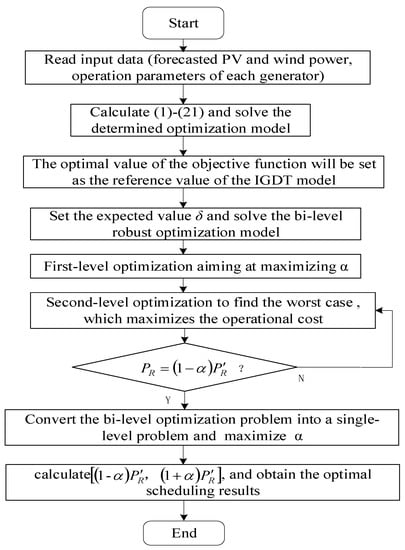
Figure 1.
The flow diagram of the proposed information gap decision theory (IGDT)-based spinning reserve optimization model.
4. Case Study
In this paper, a grid-connected microgrid system with local renewable energy generators installed is used as an example to verify the efficacy of the proposed IGDT-based spinning reserve optimization model. Figure 2 is the main structure of the grid-connected microsystem, and the rated parameters of local generators are listed in the Table 1. In addition, a 100 kWh battery is installed in this distributed system, whose maximum charging/discharging power is 50 kW. To extend battery lifespan, the minimum and maximum battery SOCs are set as 25% and 95%, respectively [24]. Finally, the predicted outputs of the PV panels, wind turbines, local demands, and real-time electricity prices are shown in Figure 3 to indicate the power supply–consumption pattern of the proposed system.
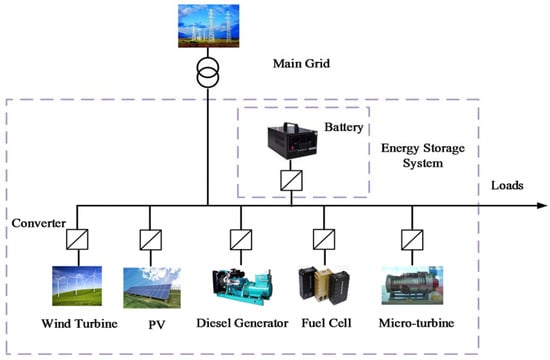
Figure 2.
The main structure of the grid-connected microsystem.

Table 1.
The rated parameters of local generators of the grid-connected microgrid.
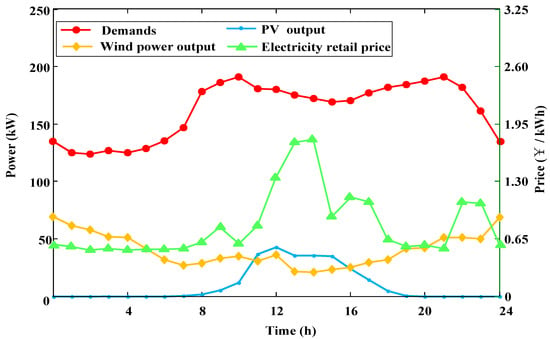
Figure 3.
The predicted outputs of the PV panels, wind turbines and local demands.
5. Results and Discussions
5.1. The Relationship between α and δ for Different Renewable Energy Penetration Rates
By applying the IGDT-based system spinning reserve optimization model, the optimization results of the relationships between the MAoSU (α) and the percentage increase of the theoretical minimum operational cost (δ) under different renewable energy penetration rates are shown in Figure 4.
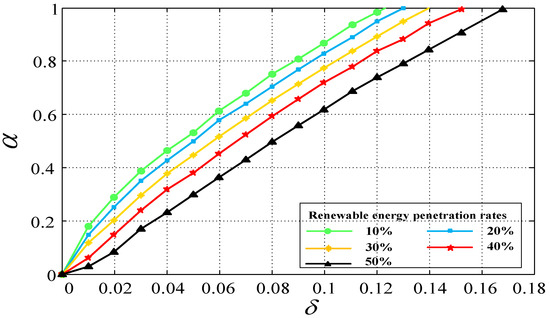
Figure 4.
The relationships between the maximum allowance of system uncertainty (MAoSU) and the percentage increase of the minimum preset operational cost.
It can be seen from Figure 4 that the percentage increase of the minimum preset operational cost (δ) is proportional to the MAoSU (α) for all of the renewable energy penetration rates. Given that δ is zero (i.e., the actual renewable energy generation is the same as the predicted values), the theoretical minimum operational cost of the system is 2153.3 Chinese Yuan when the renewable penetration rate is 30%. However, as δ increases from 0 to 14%, the MAoSU would increase 100% for the same renewable energy generation rate. In this situation, even though the operational cost increases 14%, system robustness can be maintained if the output of renewable energy is fluctuated within the range of zero to twice that of the predicted value.
Additionally, Figure 4 also reveals that with the increase of the renewable energy penetration rate, the system operational cost needs to be increased greatly in order to keep system uncertainty within the same allowance (α), especially for the high renewable energy penetration system. This is because the amplitude of the PV panel and wind turbine outputs fluctuate much more violently, and the system needs to equip more spinning reserve to maintain the same allowance of system uncertainty when the system renewable energy penetration rate is high.
In summary, to improve the robustness of a distributed system, decision-makers need to increase the operational cost to compensate for system uncertainty. The percentage increase of the operational cost is directly proportional to the MAoSU and the renewable energy penetration rate of the system.
5.2. System Optimal Operation Analysis for Different Maximum Allowance of System Uncertainties
1. Optimization Results of Spinning Reserve
As clearly demonstrated in Section 5.1, decision-makers can equip additional spinning reserve to improve the MAoSU by increasing the percentage operational cost of the system. Figure 5 and Figure 6 show the optimization results of the up-spinning reserve capacity and down-spinning reserve capacity of a system whose renewable energy penetration rate is 30%.
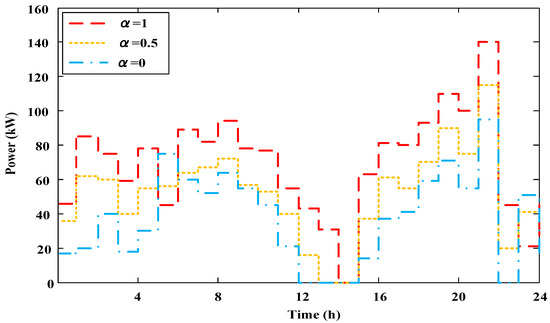
Figure 5.
Optimal up-spinning reserve capacity of a system (renewable energy penetration rate is 30%).
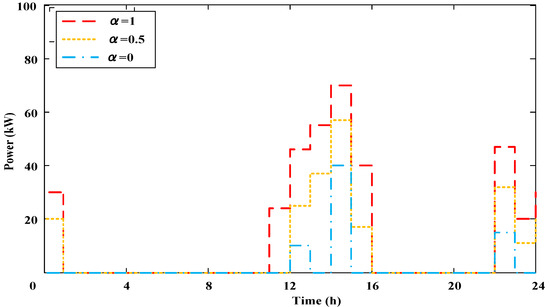
Figure 6.
Optimal down-spinning reserve capacity of a system (renewable energy penetration rate is 30%).
As can be seen from Figure 5 and Figure 6, with the increase of the MAoSU, the system needs to equip more spinning reserve capacity in order to maintain system reliability operation. In Figure 5, when α equals to 1, the maximum capacity of system up-spinning reserve is about 140 kW, which is about 93.3% of the total renewable energy installation capacity. While, when α reduces to 0.5 and 0, the maximum capacity of the system up-spinning reserve reduces to about 115 kW and 95 kW, which is about 76.7% and 63.3% of total renewable energy installation capacity, respectively. The optimization results prove that the installed up-spinning reserve capacity not only needs to compensate for the renewable energy fluctuation, it also needs to prepare for the variations in the electricity price and the interruptible loads. Meanwhile, by implementing the chance-constrained programming method proposed by Liu et al. [25], the optimal up-spinning reserve capacities of the proposed system are 85 kW, 95 kW, and 127 kW when α equals to 0, 0.5, and 1, respectively. It is easy to find that the optimal up-spinning reserve capacity is lower if the chance-constrained programming method is selected to optimize the system’s up-spinning reserve capacity. This is because the chance-constrained programming method tries to use the probability distribution function to model system uncertainty, and this method is inaccurate when it is used for a system with a high renewable energy penetration rate. Similar results are shown in Figure 6.
Moreover, in Figure 5, between 06:00–10:00 and 16:00–22:00, the equipped up-spinning reserve capacity reaches its two summits, because the output of the renewable energy system is low and system demand is relatively high in these periods, and in this situation, more up-spinning reserve needs to be equipped in order to mitigate energy shortage. However, in Figure 6, the maximum down-spinning reserve capacity shows an opposite tendency. As the output of the renewable energy system reaches its maximum value and system demand is relatively low between 12:00–16:00, the system needs to equip more down-spinning reserve in order to improve the renewable energy consumption rates. Therefore, in the same time, the equipped down-spinning reserve capacity is always inversely proportional to the up-spinning reserve capacity.
2. Optimization Results of System Scheduling
By applying the proposed IGDT-based spinning reserve optimization model, the optimization results of the daily up-spinning reserve, down-spinning reserve, and network power exchange with the main grid of different systems can be acquired. Figure 7 is an example of the optimization results for a typical system whose renewable energy penetration rate is 30% and MAoSU is 0.5. In addition, for the same system, the output power of the energy storage system and fossil energy carriers are shown in Figure 8.
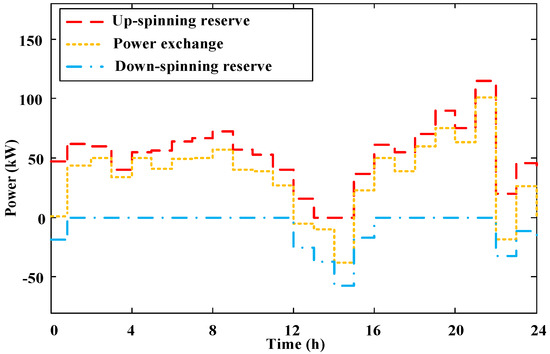
Figure 7.
Optimization results of system daily up-spinning spinning reserve, down-spinning reserve, and power exchange curves (for α = 0.5, and a renewable energy penetration rate of 30%).
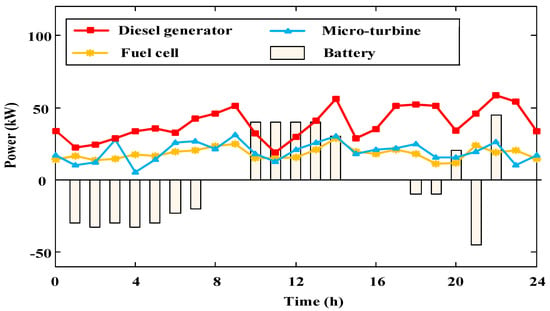
Figure 8.
Output power of energy storage system and fossil energy carriers.
Figure 7 shows that the amplitudes of the system up-spinning reserve and down-spinning reserve are always greater than the network power exchange with the main grid when α equals 0.5. In this situation, system robustness can be maintained even if the distributed network is disconnected from the main grid, i.e., working in island mode.
Additionally, the power exchange between the main grid and the distributed grid reaches its maximum value between 18:00–21:00, because for a distributed system, it is preferable to import cheaper electricity at a lower price time in order to reduce system operational costs. In this circumstance, the system needs to prepare more up-spinning reserve capacity. Similarly, between 12:00–14:00, the distributed system needs to export a large amount of electrical power in order to increase the system benefits, and in this situation, the system needs to equip more down-spinning reserve capacity.
As shown in Figure 8, even though the system’s local demands are relatively low between 01:00–7:00, the energy generated locally cannot meet the electrical demand at this time. Therefore, the system needs to import energy from the main grid in order to supply electrical loads. Additionally, considering that the electricity price is relatively low at this time, the battery system is charged at this time. However, between 10:00–13:00, with the rapid increase of network loads and retail electricity price, the battery system should be discharged in order to compensate for the system energy shortage, and meanwhile, the battery system can obtain a substantial gain by exporting electricity to the main grid. It is worth noting that the battery system is discharged at 22:00, because by the end of day, the battery capacity should be discharged to its initial value for sustainable system operation. Finally, by comparing Figure 8 with Figure 3, it can be seen that the outputs of fossil generators are greatly affected by the renewable energy generation and local demands, but are less sensitive to electricity retail price factor.
5.3. System Robustness Validation for Different MAoSU
In this part, taking the success rate of system off-grid operation (i.e., island operation) as a reliability index, 3000 groups of PV and wind power generations are used to test the robustness of the proposed spinning reserve model for each different α. Figure 9 shows the success rates of system off-grid operation for different α.
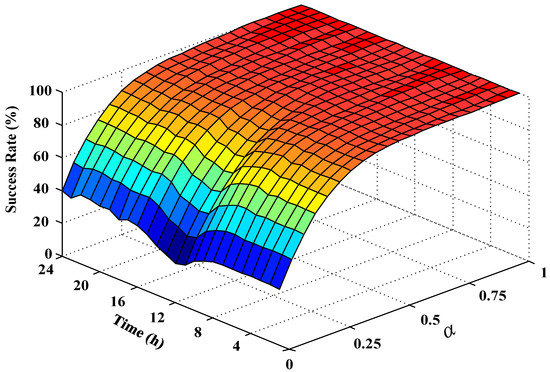
Figure 9.
Success rates of system off-grid operation for different α (renewable energy penetration rate is 30%).
Figure 9 shows that with the decrease of the MAoSU (α), the success rate of system off-grid operation decreases sharply, especially when α is less than 0.5. This is because with the decrease of the MAoSU (α), decision-makers show more interest in obtaining system benefits rather than maintaining system robustness, which will lead to the reduction of spinning reserve capacity. In this situation, the equipped spinning reserve capacity is not always greater than the power exchange between the main grid and distributed gird, and finally results in the decrease of the success rate of the system’s off-grid operation. Alternatively, by implementing the chance-constrained method proposed by Liu et al. [25] to optimize the MAoSU, the minimum MAoSU should be limited to 0.9 to keep the success rate of system off-grid operation higher than 90%. This proves that compared with the chance-constrained optimization, the proposed IGDT optimization method has better performance regarding increasing the success rate of the system’s off-grid operation when α is low.
6. Conclusions
In this paper, an improved IGDT-based spinning reserve model is proposed to maximize the MAoSU under the premise of satisfying the preset system’s operational cost. Additionally, by applying the improved IGDT-based spinning reserve model, the optimal outputs of fossil energy generators, and the energy storage system, the optimal spinning reserve capacity and optimal power exchange between the main grid and the distributed grid can be acquired. Finally, by comparing the magnitude of the optimal spinning reserve capacity with the power exchange between the main grid and the distributed grid for different MAoSUs, the success rate of the system’s off-grid operation is obtained. The three main findings of this paper can be summarized as follows:
- (1)
- In order to improve the robustness of a distributed system, decision-makers need to increase the operational cost to compensate for system uncertainty. The percentage increase of the operational cost is in proportional to the MAoSU and the renewable energy penetration rate of the system.
- (2)
- With the increase of the MAoSU, the system needs to equip more spinning reserve capacity to maintain system reliability operation. However, at the same time, the equipped up-spinning reserve capacity is always inversely proportional to the down-spinning reserve capacity. Additionally, for a given system, the outputs of fossil generators are determined by the renewable energy generation and local demands.
- (3)
- With the decrease of the MAoSU, the success rate of system off-grid operation decreases sharply, especially when α is less than 0.5. This is because with the decrease of the MAoSU, less spinning reserve capacity will be equipped to maintain system reliability operation.
Finally, compared with similar work done by Liu et al. [25], the accuracy of the proposed work has been improved. Additionally, the proposed work has better performance regarding increasing the success rate of the system’s off-grid operation when α is low.
Author Contributions
H.Z. conceived and designed the experiments; H.S. performed the experiments; Q.Z. analyzed the data; G.K. wrote the paper.
Funding
Supported by Open Fund of FX83-18-0022018 year Beijing Key Laboratory of Demand Side Multi-Energy Carriers Optimization and Interaction Technique (No. YDB51201801085).
Conflicts of Interest
The authors declare no conflict of interest.
Abbreviation
| Nomenclature | Meaning |
| CTotal | Total operational cost of the distributed system |
| CDG | Operational cost of distributed generators |
| CI/E | Energy cost of importing/exporting electricity from the main grid |
| CSR | System spinning reserve cost |
| T | Number of scheduling time periods |
| Ni | Number of distributed generators |
| CF,i(t) | Fuel cost of the ith distributed generator at time t |
| COM,i(t) | Operational and maintenance costs of the ith distributed generator at time t |
| CP(t) | Cost of purchasing electricity from the main grid at time t |
| CS(t) | Cost of selling electricity to the main grid at time t |
| EG(t) | Total electricity importing from/exporting to the main grid at time t |
| CSR,DG | Spinning reserve cost of distributed generators |
| CSR,B | Spinning reserve cost of a battery system |
| CSR,IL | Spinning reserve cost of interruptible loads |
| Nn | Number of interruptible loads |
| Ki,U | Up-spinning reserve cost coefficient of the ith distributed generator |
| Ki,D | Down-spinning reserve cost coefficient of the ith distributed generator |
| KBU | Up-spinning reserve cost coefficient of a battery system |
| KBD | Down-spinning reserve cost coefficient of a battery system |
| Kn,U | Up-spinning reserve cost coefficient of the nth interruptible load |
| Ri,U(t) | Up-spinning reserve capacity of the ith distributed generator at time t |
| Ri,D(t) | Down-spinning reserve capacity of the ith distributed generator at time t |
| RBU(t) | Up-spinning reserve capacity of a battery system at time t |
| RBD(t) | Down-spinning reserve capacity of a battery system at time t |
| Rn,U(t) | Up-spinning reserve capacity of the nth interruptible load at time t |
| Pi,min | Minimum output power of the ith distributed generator |
| Pi,max | Minimum output power of the ith distributed generator |
| Pi(t) | Output power of the ith distributed generator at time t |
| τ | The ramp-up time of distributed generators |
| ri,U | Up ramp rate of the ith distributed generator |
| ri,D | Down-ramp rate of the ith distributed generator |
| Δt | Time interval |
| PC(t) | Charging power of a battery system |
| PD(t) | Discharging power of a battery system |
| PC,max | Maximum charging power of a battery system |
| PD,max | Maximum discharging power of a battery system |
| SOC(t) | State of charge (SOC) of a battery system at time t |
| ηC | Charging efficiency of a battery system |
| ηD | Discharging efficiency of a battery system |
| EB | Installation capacity of a battery system |
| SOCmin | Lower limit of battery SOC |
| SOCmax | Upper limit of battery SOC |
| Rn,U,max(t) | Maximum up-spinning reserve of the nth interruptible load at time t |
| PW(t) | Output power of a wind turbine system at time t |
| PPV(t) | Output power of a PV system at time t |
| PG(t) | Imported/Exported electrical power from/to the main grid at time t |
| PB(t) | Power exchange of a battery system at time t |
| PD(t) | Electrical demands at time t |
| ΔPW(t) | Output fluctuations of a wind turbine system at time t |
| ΔPPV(t) | Output fluctuations of a PV system at time t |
| ΔPR(t) | Output fluctuations of renewable energy system at time t |
| C(x,d) | The optimization objective function |
| H(x,d) | Equality constraint |
| G(x,d) | Inequality constraint |
| x | Uncertain variable |
| d | Deterministic variable |
| x′ | Predicted value of the uncertain variable |
| α | Maximum allowance of system uncertainty |
| U(α,x′) | A set of uncertain variables |
| C0 | Optimal system operational cost of the proposed deterministic model |
| Cc | Preset system operational cost |
| δ | The percentage increase of the theoretical minimum operational cost |
| PR(t) | Actual output power of renewable energy system at time t |
| P′R(t) | Predicted output power of renewable energy system at time t |
| DV1 | A set of system decision variables |
| DV2 | A set of system random variables |
References
- Niknam, T.; Azizipanah-Abarghooee, R.; Narimani, M.R. An efficient scenario-based stochastic programming framework for multi-objective optimal micro-grid operation. Appl. Energy 2012, 99, 455–470. [Google Scholar] [CrossRef]
- Soares, J.; Ghazvini, M.A.F.; Borges, N.; Vale, Z. A stochastic model for energy resources management considering demand response in smart grids. Electr. Power Syst. Res. 2017, 143, 599–610. [Google Scholar] [CrossRef]
- Liu, Y.; Du, W.; Xiao, L.; Wang, H.; Bu, S.; Cao, J. Sizing a hybrid energy storage system for maintaining power balance of an isolated system with high penetration of wind generation. IEEE Trans. Power Syst. 2016, 31, 3267–3275. [Google Scholar] [CrossRef]
- Mohammadi, S.; Soleymani, S.; Mozafari, B. Scenario-based stochastic operation management of MicroGrid including Wind, Photovoltaic, Micro-Turbine, Fuel Cell and Energy Storage Devices. Int. J. Electr. Power Energy Syst. 2014, 54, 525–535. [Google Scholar] [CrossRef]
- Khazali, A.; Kalantar, M. Spinning reserve quantification by a stochastic–probabilistic scheme for smart power systems with high wind penetration. Energy Convers. Manag. 2015, 96, 242–257. [Google Scholar] [CrossRef]
- Zakariazadeh, A.; Jadid, S.; Siano, P. Smart microgrid energy and reserve scheduling with demand response using stochastic optimization. Int. J. Electr. Power Energy Syst. 2014, 63, 523–533. [Google Scholar] [CrossRef]
- Mazidi, M.; Zakariazadeh, A.; Jadid, S.; Siano, P. Integrated scheduling of renewable generation and demand response programs in a microgrid. Energy Convers. Manag. 2014, 86, 1118–1127. [Google Scholar] [CrossRef]
- Chen, J.; Wu, W.; Zhang, B.; Wang, B.; Guo, Q. A Spinning Reserve Allocation Method for Power Generation Dispatch Accommodating Large-Scale Wind Power Integration. Energies 2013, 6, 5357–5381. [Google Scholar] [CrossRef]
- Halamay, D.A.; Brekken, T.K.A.; Simmons, A.; McArthur, S. Reserve Requirement Impacts of Large-Scale Integration of Wind, Solar, and Ocean Wave Power Generation. IEEE Trans. Sustain. Energy 2011, 2, 321–328. [Google Scholar] [CrossRef]
- Jaefari-Nokandi, M.; Monsef, H. Scheduling of Spinning Reserve Considering Customer Choice on Reliability. IEEE Trans. Power Syst. 2009, 24, 1780–1789. [Google Scholar] [CrossRef]
- Mohanta, D.K.; Sadhu, P.K.; Chakrabarti, R. Deterministic and stochastic approach for safety and reliability optimization of captive power plant maintenance scheduling using GA/SA-based hybrid techniques: A comparison of results. Reliabil. Eng. Syst. Saf. 2007, 92, 187–199. [Google Scholar] [CrossRef]
- Shayesteh, E.; Yousefi, A.; Moghaddam, M.P. A probabilistic risk-based approach for spinning reserve provision using day-ahead demand response program. Energy 2010, 35, 1908–1915. [Google Scholar] [CrossRef]
- Zhang, H.; Zhang, Q.; Gong, T.; Sun, H.; Su, X. Peak Load Regulation and Cost Optimization for Microgrids by Installing a Heat Storage Tank and a Portable Energy System. Appl. Sci. 2018, 8, 567. [Google Scholar] [CrossRef]
- Aien, M.; Hajebrahimi, A.; Fotuhi-Firuzabad, M. A comprehensive review on uncertainty modeling techniques in power system studies. Renew. Sustain. Energy Rev. 2016, 57, 1077–1089. [Google Scholar] [CrossRef]
- Lorca, Á.; Sun, X.A. Adaptive Robust Optimization With Dynamic Uncertainty Sets for Multi-Period Economic Dispatch Under Significant Wind. IEEE Trans. Power Syst. 2015, 30, 1702–1713. [Google Scholar] [CrossRef]
- JØrgensen, S.E. Info-Gap Decision Theory. Ecol. Model. 2008, 211, 249. [Google Scholar] [CrossRef]
- Kazemi, M.; Mohammadi-Ivatloo, B.; Ehsan, M. Risk-Constrained Strategic Bidding of GenCos Considering Demand Response. IEEE Trans. Power Syst. 2015, 30, 376–384. [Google Scholar] [CrossRef]
- Nikoobakht, A.; Aghaei, J.; Mardaneh, M. Managing the risk of uncertain wind power generation in flexible power systems using information gap decision theory. Energy 2016, 114, 846–861. [Google Scholar] [CrossRef]
- Chen, K.; Wu, W.; Zhang, B.; Sun, H. Robust Restoration Decision-Making Model for Distribution Networks Based on Information Gap Decision Theory. IEEE Trans. Smart Grid 2015, 6, 587–597. [Google Scholar] [CrossRef]
- Kyriakopoulos, G.L.; Arabatzis, G.; Tsialis, P.; Ioannou, K. Electricity consumption and RES plants in Greece: Typologies of regional units. Renew. Energy 2018, 127, 134–144. [Google Scholar] [CrossRef]
- Mohsenian-Rad, H. Optimal Bidding, Scheduling, and Deployment of Battery Systems in California Day-Ahead Energy Market. IEEE Trans. Power Syst. 2016, 31, 442–453. [Google Scholar] [CrossRef]
- Kyriakopoulos, G.L.; Arabatzis, G. Electrical energy storage systems in electricity generation: Energy policies, innovative technologies, and regulatory regimes. Renew. Sustain. Energy Rev. 2016, 56, 1044–1067. [Google Scholar] [CrossRef]
- Yu, D.; Liu, H.; Yan, G.; Jiang, J.; Le Blond, S. Optimization of Hybrid Energy Storage Systems at the Building Level with Combined Heat and Power Generation. Energies 2017, 10, 606. [Google Scholar] [CrossRef]
- Liu, G.; Xu, Y.; Tomsovic, K. Bidding Strategy for Microgrid in Day-Ahead Market Based on Hybrid Stochastic/Robust Optimization. IEEE Trans. Smart Grid 2015, 7, 227–237. [Google Scholar] [CrossRef]
- Liu, G.; Starke, M.; Xiao, B.; Zhang, X.; Tomsovic, K. Microgrid optimal scheduling with chance- constrained islanding capability. Electr. Power Syst. Res. 2017, 145, 197–206. [Google Scholar] [CrossRef]
© 2018 by the authors. Licensee MDPI, Basel, Switzerland. This article is an open access article distributed under the terms and conditions of the Creative Commons Attribution (CC BY) license (http://creativecommons.org/licenses/by/4.0/).